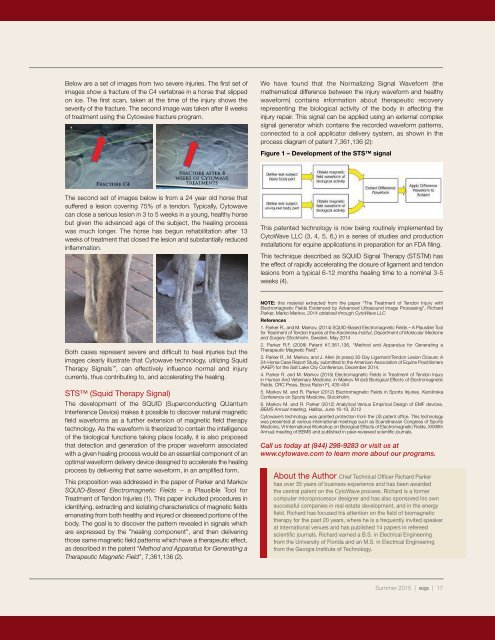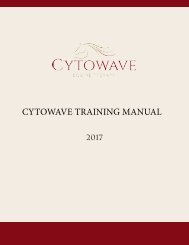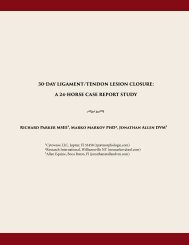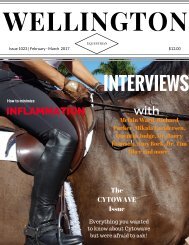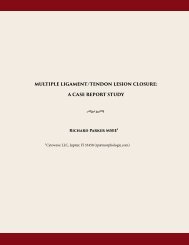Chronic Progressive Lymphedema
CPL in horses can be a devastating disease. We're hoping that Cytowave will change that.
CPL in horses can be a devastating disease. We're hoping that Cytowave will change that.
You also want an ePaper? Increase the reach of your titles
YUMPU automatically turns print PDFs into web optimized ePapers that Google loves.
◊◊<br />
Below are a set of images from two severe injuries. The first set of<br />
images show a fracture of the C4 vertebrae in a horse that slipped<br />
on ice. The first scan, taken at the time of the injury shows the<br />
severity of the fracture. The second image was taken after 8 weeks<br />
of treatment using the Cytowave fracture program.<br />
We have found that the Normalizing Signal Waveform (the<br />
mathematical difference between the injury waveform and healthy<br />
waveform) contains information about therapeutic recovery<br />
representing the biological activity of the body in affecting the<br />
injury repair. This signal can be applied using an external complex<br />
signal generator which contains the recorded waveform patterns,<br />
connected to a coil applicator delivery system, as shown in the<br />
process diagram of patent 7,361,136 (2):<br />
Figure 1 – Development of the STS signal<br />
The second set of images below is from a 24 year old horse that<br />
suffered a lesion covering 75% of a tendon. Typically, Cytowave<br />
can close a serious lesion in 3 to 5 weeks in a young, healthy horse<br />
but given the advanced age of the subject, the healing process<br />
was much longer. The horse has begun rehabilitation after 13<br />
weeks of treatment that closed the lesion and substantially reduced<br />
inflammation.<br />
This patented technology is now being routinely implemented by<br />
CytoWave LLC (3, 4, 5, 6,) in a series of studies and production<br />
installations for equine applications in preparation for an FDA filing.<br />
This technique described as SQUID Signal Therapy (STSTM) has<br />
the effect of rapidly accelerating the closure of ligament and tendon<br />
lesions from a typical 6-12 months healing time to a nominal 3-5<br />
weeks (4).<br />
Both cases represent severe and difficult to heal injuries but the<br />
images clearly illustrate that Cytowave technology, utilizing Squid<br />
Therapy Signals , can effectively influence normal and injury<br />
currents, thus contributing to, and accelerating the healing.<br />
STS (Squid Therapy Signal)<br />
The development of the SQUID (Superconducting QUantum<br />
Interference Device) makes it possible to discover natural magnetic<br />
field waveforms as a further extension of magnetic field therapy<br />
technology. As the waveform is theorized to contain the intelligence<br />
of the biological functions taking place locally, it is also proposed<br />
that detection and generation of the proper waveform associated<br />
with a given healing process would be an essential component of an<br />
optimal waveform delivery device designed to accelerate the healing<br />
process by delivering that same waveform, in an amplified form.<br />
This proposition was addressed in the paper of Parker and Markov<br />
SQUID-Based Electromagnetic Fields – a Plausible Tool for<br />
Treatment of Tendon Injuries (1). This paper included procedures in<br />
identifying, extracting and isolating characteristics of magnetic fields<br />
emanating from both healthy and injured or diseased portions of the<br />
body. The goal is to discover the pattern revealed in signals which<br />
are expressed by the ”healing component”, and then delivering<br />
those same magnetic field patterns which have a therapeutic effect,<br />
as described in the patent “Method and Apparatus for Generating a<br />
Therapeutic Magnetic Field”, 7,361,136 (2).<br />
NOTE: this material extracted from the paper “The Treatment of Tendon Injury with<br />
Electromagnetic Fields Evidenced by Advanced Ultrasound Image Processing”, Richard<br />
Parker, Marko Markov, 2014 obtained through CytoWave LLC<br />
References<br />
1. Parker R., and M. Markov, (2014) SQUID-Based Electromagnetic Fields – A Plausible Tool<br />
for Treatment of Tendon Injuries at the Karolinska Institut, Department of Molecular Medicine<br />
and Surgery Stockholm, Sweden, May 2014<br />
2. Parker R.F. (2008) Patent #7,361,136, “Method and Apparatus for Generating a<br />
Therapeutic Magnetic Field”.<br />
3. Parker R., M. Markov, and J. Allen (in press) 30-Day Ligament/Tendon Lesion Closure: A<br />
24-Horse Case Report Study. submitted to the American Association of Equine Practitioners<br />
(AAEP) for the Salt Lake City Conference, December 2014.<br />
4. Parker R. and M. Markov (2015) Electromagnetic Fields in Treatment of Tendon Injury<br />
in Human And Veterinary Medicine. in Markov M (ed) Biological Effects of Electromagnetic<br />
Fields, CRC Press, Boca Raton FL 435-454<br />
5. Markov M. and R. Parker (2012) Electromagnetic Fields in Sports Injuries. Karolinska<br />
Conference on Sports Medicine, Stockholm.<br />
6. Markov M. and R. Parker (2012) Analytical Versus Empirical Design of EMF devices.<br />
BEMS Annual meeting, Halifax, June 16-19, 2012<br />
Cytowave’s technology was granted protection from the US patent office. This technology<br />
was presented at various international meetings such as Scandinavian Congress of Sports<br />
Medicine, VI International Workshop on Biological Effects of Electromagnetic Fields, XXXIIIth<br />
Annual meeting of BEMS and published in peer-reviewed scientific journals.<br />
Call us today at (844) 298-9283 or visit us at<br />
www.cytowave.com to learn more about our programs.<br />
About the Author Chief Technical Officer Richard Parker<br />
has over 35 years of business experience and has been awarded<br />
the central patent on the CytoWave process. Richard is a former<br />
computer microprocessor designer and has also sponsored his own<br />
successful companies in real estate development, and in the energy<br />
field. Richard has focused his attention on the field of biomagnetic<br />
therapy for the past 20 years, where he is a frequently invited speaker<br />
at international venues and has published 14 papers in refereed<br />
scientific journals. Richard earned a B.S. in Electrical Engineering<br />
from the University of Florida and an M.S. in Electrical Engineering<br />
from the Georgia Institute of Technology.<br />
Summer 2015 | eqs | 17


